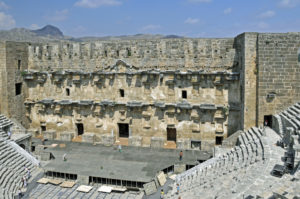
Roman Theater in Aspendos, Turkey (Photo by Don Knebel)
By the fifth century B.C., Aspendos, strategically situated on a flattop hill above the Eurymedon River that flows into the Mediterranean, had become an important port city, with its mints producing some of the world’s earliest coins. The Romans, who captured and plundered Aspendos in 79 B.C., rebuilt the city with markets, monuments, baths and temples. The ruins of many of those structures remain.
The most visited ancient structure in Aspendos is the theater, considered the best-preserved Roman theater in the world. Erected between 160 and 180 A.D. during the reign of Emperor Marcus Aurelius, the theater emulated the Greek model, with its horseshoe-shaped seating area built against the hillside. Depending on the assumed size of the average theatergoer, the estimated capacity of the 41 rows of seats, divided into two sections, ranges between 7500 and 20,000. The two-story stage house, from which actors entered the stage from one of five doors, is remarkably intact and is still used for performances.
Less well preserved than the theater, but equally impressive, are the remains of an ingenious system that brought water to the Aspendos hilltop from mountains 12 miles on the other side of the valley. The system took advantage of the principle that water seeks its own level. One 300-foot-tall stone tower near the mountains carried the water in a channel downwardly at a 55-degree angle toward horizontal pipes laid on supports in the valley. Another angled tower channeled the flowing water back up to city. The remains of the Aspendos water system are the most complete of any similar system in the world and are worth a visit after seeing the theater.